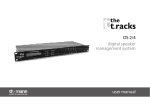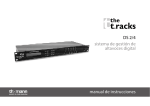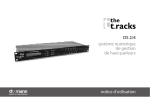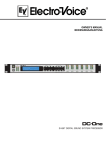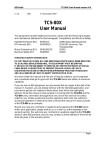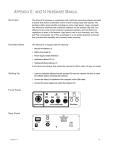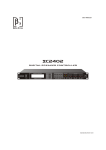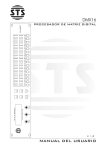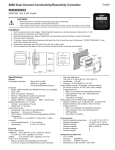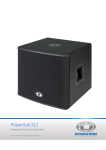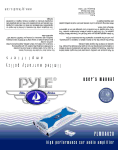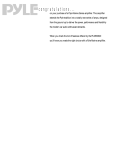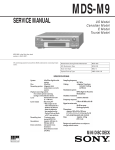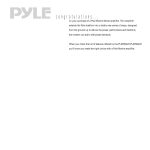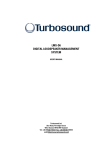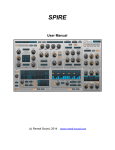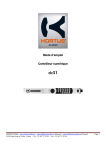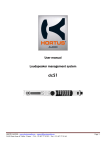Download User Manual English - CMS
Transcript
DP-II Series LOUDSPEAKER MANAGEMENT User Manual Introduction 1. Read these instructions. 2. Keep these instructions. 3. Heed all warnings. 4. Follow all instructions. 5. Do not use this apparatus near water. 6. Clean only with dry cloth. 7. Do not block any ventilation openings. Install in accordance with the manufacture’s instructions. 8. Do not install near any heat sources such as radiators, heat registers, stoves, or other apparatus (including amplifiers) that produce heat. 9. Do not defeat the safety purpose of the polarized or grounding-type plug. A polarized plug has two blades with one wider than the other. A grounding-type plug has two blades and a third grounding prong. The wide blade or the third prong are provided for your safety. If the provided plug does not fit into your outlet, consult an electrician for replacement of the obsolete outlet. 10. Protect the power cord from being walked on or pinched particularly at plugs, convenience receptacles, and the point where they exit from the apparatus. 11. Use only attachments/accessories specified by the manufacturer. 12. Use only with the cart, stand, tripod, bracket, or table specified by the manufacturer, or sold with the apparatus. When a cart is used, use caution when moving the cart/apparatus combination to avoid injury from tip-over. 13. Unplug this apparatus during lighting storms or when unused for long periods of time. 14. Refer all servicing to qualified service personal. Sevicing is required when the apparatus has been damaged in any way, such as power supply cord or plug is damaged, liquid has been spilled or objects have fallen into the apparatus, the apparatus has been exposed to rain or moisture, does not operate normally, or has been dropped. 15. The apparatus shall be connected to a MAINS socket outlet with a protective earthing connection. 16. Where the MAINS plug or an appliance coupler is used as the disconnect device, the disconnect device shall remain readily operable. The symbol, wherever is appears, alerts you to the presense of uninsulated dangerous voltage inside the enclosure-voltage that may be sufficient to constitute a risk of shock. The symbol, wherever is appears, alerts you to important operating and maintenance instructions in the accompanying literature. Please read the manual. To reduce the risk of electric shock, do not remove the top cover (or the rear section). No user serviceable parts inside. Refer servicing to qualified personnel. To reduce the risk of fire to electric shock, do not expose this appliance to rain and moisture. The apparatus shall not be exposed to dripping or splashing liquids and no objects filled with liquids, such as vases, shall be placed on the apparatus. These service instructions are for use by qualified service personal only. To reduce the risk of electric shock do not perform any servicing other than that contained in the operation instructions. Repairs have to be performed by qualified service personal. CAUTION RISK OF ELECTRIC SHOCK DO NOT OPEN DO NOT EXPOSE TO RAIN, MOISTURE, DRIPPING OR SPLASHING Introduction The DP-II Series are powerful DSP based loudspeaker processors, ideally suited for install application, where they combine the functions of a multitude of conventional products in a compact 1U unit with extensive remote control capabilities. To achieve this, the DP Series devices have two inputs, three inputs, and four inputs and up to eight outputs. Base crossover modes: 6 Outputs have 2x2 way, 2x3 way, 4+2 way, 5+1 way and 6 way. 4 Outputs have 2x2 way, 3+1 way, 4 way and 2 MonoSub. Units also offer “Source” for free assign signal, which allows completely flexible routing of any output from any combination of inputs. Each input has a gain control, multi-type filters. Filter types included parametric equalisation, high & low shelving. Each output has a gain control, variable delay line, highpass and lowpass crossover filters, seven band multi-type filters, polarity, input signal source, a limiter. The crossover filters offer slopes of up to 48dB/Octave. Security lock-out is avaiable for each parts. Supply external device remote controls. Remote port is RS232 . Front Panel 5 3 4 1 2 1. LCD Sreeen: Show, the name of last recalled memory on the bottom line of the screen, and current device model name on the top line. Also used to show all parameters as they are edited, and all menu selections. 2. BACK/ NEXT: Moves backwards or forward through list of parameters. MENU: Activates the main menu. BYPASS: Bypass filter. QUIT: Quit key. ENTER: Enter key. 3. Rotary Encoders: Three velocity encoders adjust parameters. 4. MUTE: These buttons illuminate when pressed and mute audio for that channel. (Press and Hold 3 seconds) Access current channel parameters. 5. Meters: Input and Output meters show dB from clipping point. Red CLIP LED show signal overflow, Yellow LED show signal near -3dB. Rear Panel ~ 1 2 4 3 1. Power Switch: turns the device’s mains supply off and on. 2. RS232: RS232 standard via a 9 pin D-type connector, for connection to PC. 3. Audio Inputs: 3 pin XLR sockets are provided for each channel. All are fully balanced, pin 2 hot, 3 cold, 1 screen. 4. Audio Outputs: 3 pin XLR sockets are provided for each channel. All are fully balanced, pin 2 hot, 3 cold, 1 screen. Diagram of input channels MUTE PEQ GAIN INPUT A Diagram of output channels HPF LPF PEQ DELAY GAIN LIMITER MUTE OUTPUT 1 Input Gain The range of the control over the input gain is -40dB to +6dB in 0.1dB steps. InputA Gain Gain = + 0 . 0dB Gain Input Parametric EQ Pressing BYPASS will bypass the All bands EQ. InputA All-EQ Bypass = Off Bypass The range of frequency is 20Hz to 20kHz in 1/36 Octave. The range of Q is 0.4 to 128. The range of gain is -30dB to +15dB in 0.1dB steps. InputA PEQ : 01 1k00Hz Q=3 . 0 +0 . 0dB Frequency ‘Q’ Gain Frequency ‘Q’ Gain Frequency ‘Q’ Gain Pressing BYPASS will bypass the current band EQ. InputA PEQ : 01 1k00Hz Q=3 . 0 +0 . 0dB Bypass While filter was in BYPASS ON, Changing the filter type is achieved by pressing ENTER. ( LoShelf ) ( HiShelf ) InputA LSF : 01 1k00Hz Q= . 71 +0 . 0dB InputA HSF : 01 1k00Hz Q= . 71 +0 . 0dB Input Link Set link value for channel, while modify parameters, the channel of have same link value will modify together. InputA Link Link = None Link Output Gain The range of the control over the input gain is -40dB to +15dB in 0.1dB steps. Out1 Output1 Gain Output Gain = + 0 . 0dB Gain Output Polarity The polarity (or phase) of each output may be switched individually. Out1 Output1 Polarity Polarity = [+] - or + Output Delay The maximum avaiable delay depend on different devices. Out1 Output1 Delay Delay = 0 . 000mS x10mS 3.43 m x1mS 343mm x10uS 4mm Output Highpass/Lowpass Filter The highpass/lowpass filter on each output has a frequency range of 20Hz to 20kHz in 1/36 Octave steps. Crossover slope can be 6dB, 12dB, 18dB, 24dB, 36dB and 48dB/Octave. Filter type can be Butterworth, Linkwitz-Riley, Bessel. Out1 Output1 HPF 20 . 5Hz Butwrth 24dB Frequency Slope Out1 Output1 LPF 20k2Hz Lnk/Ril 48dB Frequency Slope Output Parametric EQ Pressing BYPASS will bypass the All bands EQ. Out1 Output1 All-EQ Bypass = Off Bypass The range of frequency is 20Hz to 20kHz in 1/36 Octave. The range of Q is 0.4 to 128. The range of gain is -30dB to +15dB in 0.1dB steps. Out1 Output1 PEQ : 01 1k00Hz Q=3 . 0 +0 . 0dB Frequency ‘Q’ Gain Frequency ‘Q’ Gain Frequency ‘Q’ Gain Pressing BYPASS will bypass the current band EQ. Out1 Output1 PEQ : 01 1k00Hz Q=3 . 0 +0 . 0dB Bypass While filter was in BYPASS ON, Changing the filter type is achieved by pressing ENTER. ( LoShelf ) ( HiShelf ) Out1 Output1 LSF : 01 1k00Hz Q= . 71 +0 . 0dB Out1 Output1 HSF : 01 1k00Hz Q= . 71 +0 . 0dB Output Limiter The limiter on each output has adjustable attack time, release time and threshold. The range of attack time 0.3 to 90mS, the range of release time 0.1 to 2.0 second, the range of threshold -10dB to +15dB in 0.1dB steps. Out1 Output1 Limiter A:1 . 4mS R:2 . 0S +15dB Attack Release Threshold Output Channel Name For edit channel name by pressing ENTER. Cursor will blink on first character position. Turn rotary encoder and modify character, move cursor position by pressing BACK or NEXT. Pressing ENTER again for confirm and store channel name. Out1 Output1 Name Name = Output1 Char Source The source on each output, can assign signal rounting from input channel, create free Xover combination. Out1 Output1 Source = Source A Source Pressing ENTER will switch each input channel mix gain. Out1 Output1 InputA Mix Gain = +0 . 0dB MixGain Output Link Set link value for channel, while modify parameters, the channel of have same link value will modify together. Out1 Output1 Link Link = None Link Menu System Pressing MENU will enter menu system. Pressing ENTER will enter sub-menu. MAIN MENU :...... Program Sub - Menu MAIN MENU : . . . . . . CopyTools Sub - Menu MAIN MENU :..... . Interface Sub - Menu MAIN MENU : . . . . . . System Sub - Menu MAIN MENU : . . . . . . Security Sub - Menu Program Sub-menu Load Factory Program. Load User Program. Design a Xover. Save User Program. Delete User Program. PROGRAM MENU :... Load User Program Pressing ENTER will enter Load User Program sub-menu. Load User Program 01 : 2x3 Way Xover Turn rotary encoder to change program index, Pressing ENTER [ ENTER ] for Recall . 01 : 2x3 Way Xover Pressing ENTER for confirm and load program. Loading New Program 01 : 2x3 Way Xover PROGRAM MENU :... Design a Xover Design a Xover Type : 2x2 WAY XOVER New Xover [ ENTER ] to Confirm About Xover mode details, see Appendix I. Pressing ENTER will enter Design a Xover sub-menu. Turn rotary encoder to change Xover mode, Pressing ENTER Pressing ENTER for confirm and change Xover mode. PROGRAM MENU :... Save User Program Save User Program 01 : 2x3 Way Xover ? [ ENTER ] to Overwrite 01 : 2x3 Way Xover ? Set Program Name 01 : 2x3 Way Xover ? [ ENTER ] to Save 01 : 2x3 Way Xover ? Pressing ENTER will enter Save User Program sub-menu. Turn rotary encoder to change program index, Pressing ENTER. Pressing ENTER for confirm and overwrite program. Pressing QUIT for exit. Program name length is 16 character. Turn rotary encoder and modify character, move cursor position by pressing BACK or NEXT. Pressing ENTER again for confirm and store program name. Pressing QUIT for exit. Pressing ENTER for confirm and Save program. Saving to Memory 01 : 2x3 Way Xover ? PROGRAM MENU :... Delete User Program Pressing ENTER will enter Delete User Program sub-menu. Delete User Program 01 : 2x3 Way Xover Turn rotary encoder to change program index, Pressing ENTER. [ ENTER ] to Delete . 01 : 2x3 Way Xover Pressing ENTER for confirm and delete program. Deleting Memory ... 01 : 2x3 Way Xover CopyTools Sub-menu Copy Input Section Copy Output Section COPYTOOLS MENU :... Copy Input Section Copy Input Section Source : A Target : B On Copy Input Section screen, Turn rotary “FREQ”encoder change source channel, Turn rotary “Q” encoder change target channel. Pressing ENTER to confirm and copy intput channel parameters. COPYTOOLS MENU :.. . Copy Output Section Copy Output Section Source : 1 Target : 2 On Copy Output Section screen, Turn rotary “FREQ”encoder change source channel, Turn rotary “Q” encoder changetarget channel. Pressing ENTER to confirm and copy output channel parameters. System Sub-menu SYSTEM MENU :...... LCD Contrast SYSTEM MENU :...... LED Brightness SYSTEM MENU :...... Wake - up Time SYSTEM MENU :...... Filter Q or BW Turn rotary encoder to change LCD contrast, Pressing ENTER to confirm and save. Turn rotary encoder to change LED brightness, Pressing ENTER to confirm and save. Device startup wake up time. Mute Hold, set to keep mutes on when powered up. 0 secs......60 secs, set wait time before the audio fades in. Turn rotary encoder to change parameter, Pressing ENTER to confirm and save. Select filter Q or Bandwidth display unit. Turn rotary encoder to change parameter, Pressing ENTER to confirm and save. SYSTEM MENU :...... DelayTime / Distance Select delay time or distance. Turn rotary encoder to change parameter, Pressing ENTER to confirm and save. SYSTEM MENU :...... Output LED Meter Select output meter indicate style. output Level or attenute on limiter. Turn rotary encoder to change parameter, Pressing ENTER to confirm and save. SYSTEM MENU :...... Load Program Option SYSTEM MENU :...... Device Name Title [ ENTER ] to Editing Tit : Speaker Processor Set Device NameTitle Tit : Speaker Processor [ ENTER ] to Store Tit : Speaker Processor Select load program option. AutoMute: Force all output mute on after loading program. LoadMute: Load output MUTE status in program stored. Turn rotary encoder to change parameter, Pressing ENTER to confirm and save. Change device title name on LCD screen top line. Pressing ENTER to edit. Device name length is 16 character. Turn encoder and modify character. move cursor position by pressing BACK or NEXT. Pressing ENTER for confirm. Pressing QUIT for exit. Pressing ENTER again for confirm and store. Interface Sub-menu INTERFACE MENU :.... Interface Setup Interface Setup Master Source: RS232 Select communication port: RS232. INTERFACE MENU :.... Protocol Setup Protocol Setup Select: PCsw Ctrl Protocol Setup Select: ESRP Ctrl Select control protocol. PCsw: select PC control. ESRP: select external simple control device. Security Sub-menu Pressing ENTER will enter Security sub-menu. Lock status setting: No Lock: without lock out. Control: cannot change. Display: cannot view. Xover Only Xover + Trim Xover + Trim + Mute Changes Only Input Gain No Lock No Lock No Lock Control Display Control Display Input PEQs No Lock No Lock No Lock Control Display Control Display Input Links No Lock No Lock No Lock Control Display Control Display Output Gain No Lock Display Display Control Display Control Display Output Delay Display Display Display Control Display Control Display Output PEQs Display Display Display Control Display Control Display HPFs & LPFs Display Display Display Control Display Control Display Output Links Display Display Display Control Display Control Display Output Phase Display Display Display Control Display Control Display Limiters Display Display Display Control Display Control Display Matrix Gains Display Display Display Control Display Control Display Input Mutes No Lock No Lock No Lock No Lock No Lock Control Control Output Mutes No Lock No Lock Control No Lock No Lock Control Control Output Name Control Control Control Control Control Control Control Menu System No Lock No Lock No Lock No Lock No Lock No Lock Control Memory Store No Lock No Lock No Lock No Lock No Lock No Lock Control Memory Load No Lock No Lock No Lock No Lock No Lock No Lock Control File Operation No Lock No Lock No Lock No Lock No Lock No Lock Control Changes + View Changes + Mutes In “User Specific” setting, you can free set up lock status depend on each function part. Enter Password [******] Enter Password [******] Confirm Password [******] UnLocking Unit [******] Locking Unit [******] Speaker Processor 2 X 3 Way Xover Pressing ENTER will enter password. Turn rotary encoder and modify character, move cursor position by pressing BACK or NEXT. Pressing ENTER for enter password again. while twice time password match, system will lock unit. EVERYTHING Specifications Inputs: 2 electronically balanced. Impedance: > 10k ohms. CMRR: > 75dB 50Hz ~ 10kHz. Outputs: 4/6 electronically balanced. Source Imp: < 60ohms Min. Load: 600ohm Max. Level: +15dBm Digital Audio Sample Rate: 96kHz Frequency Response: +/- 0.5dB, 20Hz ~ 20kHz Distortion: < 0.02% @1kHz, +15dBm ADC Dynamic Range: > 110dB, 20Hz ~ 20kHz (A-Weight) DAC Dynamic Range: > 110dB, 20Hz ~ 20kHz (A-Weight) Propagation Delay: 0.21mS (DP240-II / DP260-II) Delay: 10mS(Output) Min Step Size: 0.010mS(4mm) Input Gain: -40dB to +6dB in 0.1dB steps Output Gain: -40dB to +15dB in 0.1dB steps Multi-Type Filters 10 per Input, 7 per Output. Freq. Range: 20Hz ~ 20kHz, 1/36 Octave steps. Filter Q/BW: 0.4 to 128. Filter Type: parametric equaliser HiShelf, LoShelf High and Lowpass Filters Freq. Range: 20Hz ~ 20kHz, 1/36 Octave steps. Slope: 6/12/18/24/36/48 dB/Octave. Type: Butterworth, Linkwitz-Riley, Bessel. Limiters Threshold: -10 ~ +15dB, 1dB steps. Attack time: 0.3 ~ 90mS. Release time: 0.1 ~ 2.0 second. Display: 2x20 Character LCD Connectors Inputs: 3 pin female XLR Output: 3 pin male XLR RS232: 9 pin DEE connector Power: 3 pin IEC Power Voltage: ~220V @50/60Hz Power Consumption: < 15 watts Weight: 2.7kg. Net (4.0kg. Shipping) Size: 1.75”(1U) x 19” x 7.7” (44 x 482 x 197 mm) Appendix I - Crossover Configurations 2x2 Way ( DP260-II ) 2x3 Way ( DP260-II ) INPUT OUTPUT INPUT OUTPUT A 1 A 1 OUTPUT OUTPUT 2 2 INPUT OUTPUT OUTPUT B 3 3 OUTPUT INPUT OUTPUT 4 B 4 OUTPUT OUTPUT 5 5 OUTPUT OUTPUT 6 6 4+2 Way ( DP260-II ) INPUT A 5+1 Way ( DP260-II ) OUTPUT 1 INPUT OUTPUT A 1 OUTPUT OUTPUT 2 2 OUTPUT OUTPUT 3 3 OUTPUT OUTPUT 4 4 INPUT OUTPUT B 5 OUTPUT 6 6 Way ( DP260-II ) INPUT OUTPUT A 1 OUTPUT 2 OUTPUT 3 OUTPUT 4 OUTPUT 5 OUTPUT 6 OUTPUT 5 INPUT OUTPUT B 6 2x2 Way ( DP240-II ) 3+1 Way ( DP240-II ) INPUT OUTPUT INPUT OUTPUT A 1 A 1 OUTPUT OUTPUT 2 2 INPUT OUTPUT OUTPUT B 3 3 OUTPUT INPUT OUTPUT 4 B 4 4 Way ( DP240-II ) 2 Mono Sub ( DP240-II ) INPUT OUTPUT INPUT OUTPUT A 1 A 1 OUTPUT OUTPUT 2 2 OUTPUT OUTPUT 3 3 OUTPUT INPUT OUTPUT 4 B 4 Appendix II - Different Device Comparision Model DP260-II Channel DP240-II 2 Delay Filter Channel 10 6 4 Filter 7 Delay 10mS



















